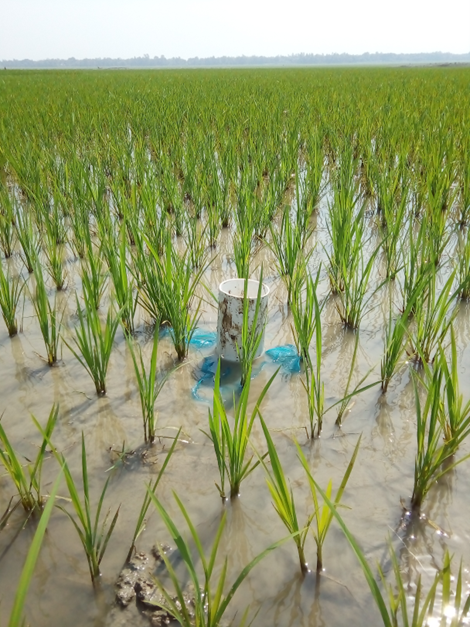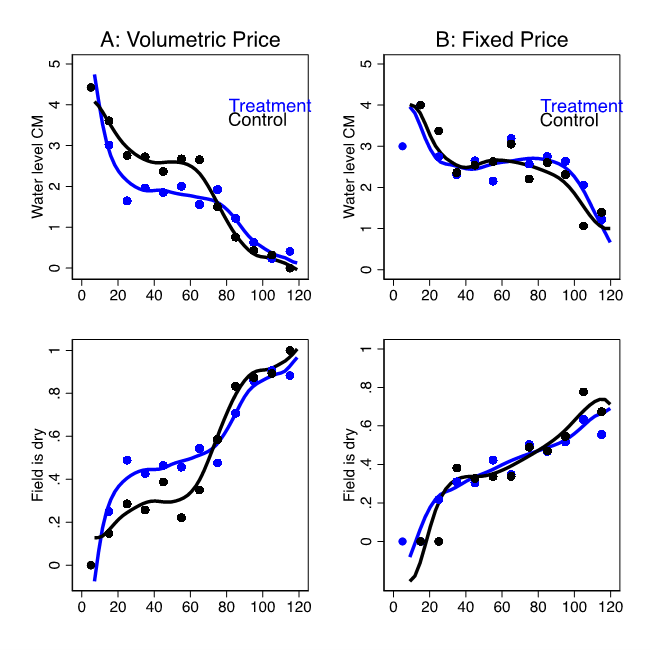
The prevalence of fixed prices can explain the low adoption of efficient irrigation technology, but incentivising farmers to convert to marginal pricing does not reduce water usage
Water is expected to become increasingly scarce with climate change, and since agriculture accounts for almost 70% of global water consumption, it has long been a focus area for efforts to preserve water.
These efforts frequently include the promotion of water-efficient technologies but in many countries, farmers have few incentives to conserve because they pay fixed (seasonal) prices for irrigation water. In such cases, volumetric prices (i.e. paying based on the amount of water used) are a common policy recommendation (Zilberman and Schoengold 2005), yet there is little evidence that investigates the interplay between volumetric prices, technology adoption, and conservation.
Experiment 1: The role of pricing in water conservation
In Chakravorty, Dar and Emerick (2023) we look at the interaction between marginal (per-unit) prices and the use of water-saving technology using two randomised experiments. Both experiments focus on Alternate Wetting and Drying (AWD), which involves using a perforated PVC pipe to monitor below-ground water levels (see Figure 1). This technology helps farmers prolong dry periods in between irrigations, reducing overall water use during the season. Numerous agronomic trials show that AWD saves water, does not compromise rice yields, and reduces methane emissions. However, despite being widely promoted in Bangladesh, AWD adoption remains low and our research examines how the lack of volumetric water pricing may limit the technology’s effectiveness.
Figure 1: An AWD pipe in use in Bangladesh

Our first experiment provided 2,000 random farmers with an AWD pipe, training on how to use it, and free installation. Another 2000 control farmers received no pipes or training. About two thirds of our sample pays for water with seasonal fees, while the remaining one third faced a marginal price for water. Using this variation, we analysed whether the effectiveness of AWD depends on how water is priced.
Unlike in agronomic trials, we found that in the field, AWD leads to a small and statistically insignificant change in water use. However, this effect varied across our sample, and the AWD treatment did reduce water use when farmers face a volumetric price for water. Figure 2 shows that in the volumetric pricing sub-sample, AWD fields had less water on them, and were more likely to be dry during the early season when most irrigation happens. There were no treatment effects when farmers were buying water with seasonal charges.
Figure 2: Pricing and water use

Notes: Water levels in centimetres (top panel) and an indicator for fields with no standing water (bottom panel) on the days after transplanting. The dots show average values from 10 day bins.
Experiment 2: Encouraging volumetric pricing
Building on this experiment, we did another RCT to evaluate whether converting farmers to marginal pricing increases uptake of AWD and saves water. Government tubewells in northwestern Bangladesh are equipped with meters where farmers can use a prepaid debit card to buy water by the hour, yet there are many villages where only a few farmers have cards. These farmers buy water and sell to other villagers with fixed seasonal charges. We identified a sample of 144 villages where farmers buy water in this way, and then randomly selected 96 villages for a treatment where farmers were provided information on how the cards work, the application fee was fully subsidised and the form was filled out, and the active cards were delivered to farmers. We then offered farmers an AWD pipe at a random price in all 144 villages. Later during the season, we measured how much water stood in their fields.
This second experiment had two main findings. First, the incentive to convert to hourly pricing made farmers’ demand for AWD less sensitive to price. The demand elasticity for AWD fell by 33% in villages where we intervened to encourage hourly irrigation pricing. Second, we found that the prepaid card treatment had no measurable effect on the likelihood that farmers were drying their fields.
Conclusions and policy implications
Our first experiment shows that the lack of volumetric pricing might explain low uptake of water-saving technology. Research in India has also found that drip irrigation did not save water when it is pumped at prices near zero (Fishman, Gine and Jacoby, 2023). In our case, when prices create the right incentives, farmers use AWD, save water, and increase their profits. The Government of Bangladesh along with numerous NGOs are engaged in efforts to scale AWD in Bangladesh and precise targeting of these efforts to places where water prices are linked to volume can help achieve environmental benefits without expending effort in places where AWD is unlikely to be taken up.
At the same time, encouraging farmers to voluntarily opt in to metered water pricing in our second experiment did not conserve water. This could be because high-volume users are resistant to volumetric prices, or that paying for each hour of irrigation is costlier for farmers located further from the pump. A desire for fairness would then cause communities to favour uniform seasonal pricing. Lastly, fractured landholdings make it efficient for numerous plots to be irrigated at once and individual payment systems are harder to operationalise in this setting with communal water distribution (Ostrom and Gardner, 1993). We see this as an opportunity for further work that evaluates different ways to promote water-saving technology when communities favour seasonal water pricing.
References
Chakravorty, U, M H Dar, and K Emerick (2023), "Inefficient water pricing and incentives for conservation." American Economic Journal: Applied Economics 15(1): 319-50.
Fishman, R, X Giné, and H G Jacoby (2023), "Efficient irrigation and water conservation: Evidence from South India." Journal of Development Economics: 1030-51.
Ostrom, E, and R Gardner (1993), “Coping with asymmetries in the commons: self-governing irrigation systems can work." Journal of Economic Perspectives 7(4): 93-112.
Zilberman, D, and K Schoengold (2005), “The use of pricing and markets for water allocation." Canadian Water Resources Journal 30(1): 47-54.


